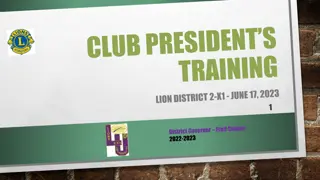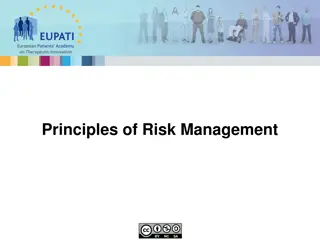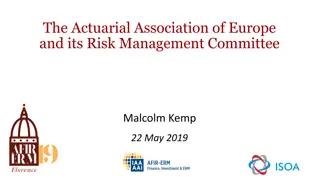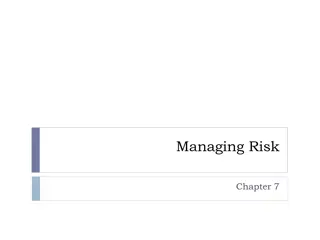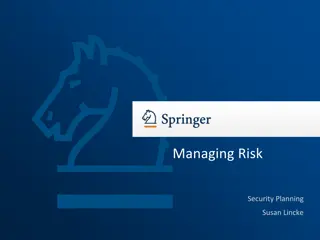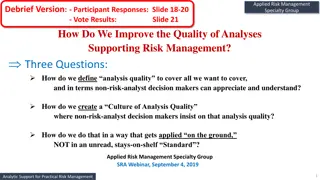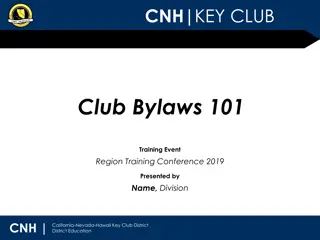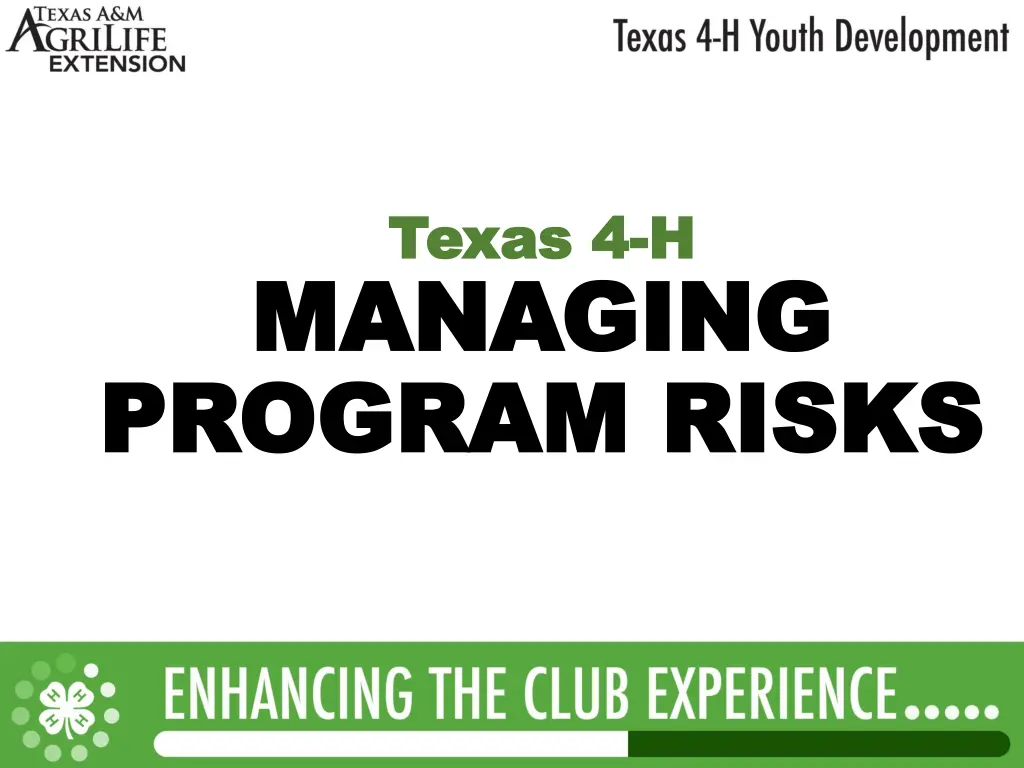
Risk Management in Texas 4-H: Policies, Strategies, and Best Practices
Explore the importance of risk management in Texas 4-H programs, focusing on safety, prevention, and liability reduction. Learn about managing program risks, assessing potential dangers, and key terminology in risk management within the context of youth protection. Discover detailed policy guides, enrollment requirements, and essential documentation for ensuring a safe and secure environment for youth participants and volunteers in Texas 4-H.
Download Presentation

Please find below an Image/Link to download the presentation.
The content on the website is provided AS IS for your information and personal use only. It may not be sold, licensed, or shared on other websites without obtaining consent from the author. If you encounter any issues during the download, it is possible that the publisher has removed the file from their server.
You are allowed to download the files provided on this website for personal or commercial use, subject to the condition that they are used lawfully. All files are the property of their respective owners.
The content on the website is provided AS IS for your information and personal use only. It may not be sold, licensed, or shared on other websites without obtaining consent from the author.
E N D
Presentation Transcript
Texas 4 Texas 4- -H H MANAGING MANAGING PROGRAM RISKS PROGRAM RISKS
Managing Program Risks Managing Program Risks Risk Management Overview Texas 4-H Risk Management and Child Protection Policies Strategies for Assessing Risk Best Practices in Youth Protection
Why Pay Attention to Risk Why Pay Attention to Risk Management? Management? It focuses on safety and prevention and becomes an important educational component of programs When risk management is addressed - participants can focus on learning in a safe, comfortable environment. It limits the liability exposure for volunteers.
What is Risk Management? What is Risk Management? When a 4-H club, group or planning committee anticipates potential risks as the activity is planned and determines ways to manage these risks.
Risk Management Terms Risk Management Terms Liability -- Legally bound or responsible. Something for which one is liable; an obligation, a responsibility, or a debt. Negligence -- Failure to use that degree of care which an ordinary person of reasonable prudence would use under the given or similar circumstances.
Texas 4 Texas 4- -H Risk Management H Risk Management Policy Guides Policy Guides Texas 4-H Rules & Guidelines* Updated and published annually Texas 4-H Ethics Policy for livestock projects* Reviewed and updated annually Programs for Minors Required Documentation* Contact County Extension Office to see if activities meet the requirements and are included in the policies Extension Employee and Volunteer Liability Covered under Education Code Legislation Section 51.937 *Publications and related information can be found on the Texas 4-H website: texas4-h.tamu.edu/
Texas 4 Texas 4- -H Risk Management H Risk Management - - Enrollment Policies Enrollment Policies Youth members and adult volunteers are considered to be official members and covered under the protections provided they have met the requirements and are ACTIVELY enrolled thru 4HOnline(online enrollment system) Member Enrollment forms include a Code of Conduct, Media Release, Consequences of Misbehavior and Waiver.
Texas 4 Texas 4- -H Risk Management H Risk Management - - Release Forms Release Forms A sample Waiver, Indemnification and Medical Treatment Authorization Form is available online (https://texas4- h.tamu.edu/management/) for counties to use for county events which might include, but are not limited to: County Camp (not at 4-H Center) required unless facility has a similar form County Exchange Trips required if overnight, recommended for all Overnight tips - required Day trips & Extended days recommended when travel is involved, or activity might result in injury Programs involving more than 2 consecutive days - required The Texas 4-H Conference Center has required release forms for events held at their facility
Texas 4 Texas 4- -H Risk Management H Risk Management - - Participant Insurance Participant Insurance Policies Policies ACTIVELY Enrolled 4-H members in county programs are included in the Texas 4-H, Inc. blanket policy The policy includes liability and accidental/medical insurance coverage through American Income Life.
Texas 4 Texas 4- -H Risk Management H Risk Management - - Volunteer Liability Policy Volunteer Liability Policy Volunteers approved through the 4-H volunteer screening process and in good standing in 4-H are covered for civil liability under Section 51.937 of the Education Code, are expected to: Act within the scope of duties as a volunteer Act in good faith and without negligence This liability policy does not apply to the operation of motor vehicles The volunteer s personal homeowner's insurance and automobile insurance is considered primary liability insurance.
Texas 4 Texas 4- -H Risk Management H Risk Management Volunteer Guides Youth Volunteer Guides Youth Protection Standards Protection Standards Programs for Minors Policies Programs for Minors Policies Volunteers must pass Youth Protection Standards screening (background checks) or provide proof of screening by an approved entity Volunteers must be re-screened every three years Required online (Child Protection and Adult Volunteer Orientation) training for volunteers must be completed before approval to serve in a volunteer role Child Protection and Adult Volunteer Orientation Training thru 4HOnline Child Protection Training - required every 2 years
Texas 4 Texas 4- -H Risk Management H Risk Management Policies Policies - - Chaperoning Chaperoning Chaperones for overnight trips must be 21 years of age Ratio of chaperones to youth of the same gender is 1:8 Adult chaperones should not be assigned to the same hotel or dorm room as the youth Exception: at the 4-H Conference Center, an adult is assigned to a dorm side with up to 12 youth. Whenever possible, a teen leader or second adult should also be assigned to this room
Texas 4 Texas 4- -H Risk Management H Risk Management Policies: Transportation Policies: Transportation All volunteers who transport youth must be a certified 4-H volunteer, have a valid drivers license and carry vehicle insurance Volunteers must be 18 years of age to serve as a driver Adults should avoid traveling alone with a child Seatbelts should be used for every passenger 12 and 15 passenger vehicles should not be used
Texas 4 Texas 4- -H Risk Management H Risk Management Policies Policies - - Facilities Facilities Insurance Insurance 4-H events under the direction of an Extension employee may utilize a form letter provided by State 4-H Office for facilities that request proof of liability insurance. Some facilities will not recognize the form letter, and counties may still have to purchase a liability policy for the event.
Texas 4 Texas 4- -H Risk Management H Risk Management - - Strategies for Assessing Strategies for Assessing Program Risks Program Risks Identify the activity Identify the potential risks Identify the seriousness of the risks (continuum from minor to life altering or death) Identify the probability of the risk occurring (continuum from not likely to highly likely) Identify strategies to manage the risk (reduce, transfer, avoid, assume) *see TX 4-H website for sample risk assessment matrix: https://texas4-h.tamu.edu/
Texas 4 Texas 4- -H Risk Management H Risk Management Strategies Strategies - - Managing Managing Program Risks Program Risks Accept and Transfer undertake the risk and responsibility and transfer the liability to another party through an insurance policy Manage and reduce lessen the extent of harm though appropriate practices and mechanisms Discontinue remove hazard or change activity due to high risk of serious injury and high probability of occurrence
Risk Management Strategies Risk Management Strategies Accept/Transfer Accept/Transfer To take upon oneself; undertake. Examples: Check with the county office to determine if your activity meets the documentation requirements for Programs with Minors Make sure volunteers and members are officially enrolled in the program Use the Indemnity, Waiver and Medical Release Form provided by the State 4-H Office and approved by legal counsel for county activities and trips Have all participants complete the release form before participating in Ropes Course at the 4-H Conference Center or other facilities offering similar activities
Strategies for Reducing Strategies for Reducing Risk Risk Manage/Reduce Manage/Reduce To lessen in extent, amount, number, degree, or price. To gain control of. Examples: Use a meeting room on the first floor of a public building Use gates with latches at the stock show to keep animals from getting out of pens Post food safety instructions in kitchen facilities
Risk Management Risk Management Strategies Strategies Discontinue Taking steps to remove a hazard, engage in an alternative activity, or otherwise end a specific exposure. Examples: Change the camp schedule and move the midnight hike to the day time Change facilities if the conditions and maintenance are not adequate Cancel the canoe trip the weekend after the flood Discontinue
Best Practices Best Practices - - Working With Youth With Youth Keep the County Extension Office informed of your activity plans Be proactive in assessing and managing risks Work in open places. Always encourage parents to attend. Always have two adults present. Working
Best Practices Best Practices - - Working With Youth With Youth Working Post and communicate safety rules. Provide written guidelines and rules for selection processes. Be alert to emotional needs. Supervise youth at all times Stop bullying and inappropriate behavior immediately
Best Practices Best Practices - - Working With Youth With Youth Working Never use physical punishment or deny basic needs. Respect the privacy of youth. When physical contact is needed to demonstrate a skill or technique, first ask for permission from the child. Never work or travel alone with a child.
Determining Determining if Negligence is Present Negligence is Present You transport 10 kids to judging contest and you only have seats for 8 kids plus the driver and you had a wreck. if Would this be an example of negligence? YES! You should always follow the law. When transporting youth, carry only as many as you can accommodate with seats and seatbelts. Check and insist that youth and adults are using seatbelts.
Determining if Determining if Negligence is Present Negligence is Present You schedule the county food show and one of the 4-H members cuts her finger with a knife when preparing her dish for judging. What proactive measures could you have taken to avoid being perceived as negligent? Make sure every participant is covered with the limited accident insurance (enrolled as a 4-H member) Assign volunteers to be present and supervise youth when prepping their dishes for judging Provide pre-activity direction on how to safely use knives in food preparation Provide plastic silverware for participants to use instead of sharp knives.
What Would You Do? What Would You Do? QUESTION: The 4-H Council is sponsoring a dance. Some parents bring a cooler of alcoholic beverages to the event, and you are working the gate. The advertisement poster said, No Alcohol Allowed. What do you do? ANSWER: Do not allow them to bring cooler in; if needed, call for back up support from the county agent or law enforcement.
What Would You Do? What Would You Do? QUESTION: The county is recruiting volunteers to serve as a chaperone for 4-H County Camp, a 2- night/3-day event. A former 4-H er would like to go as a chaperone and is 20 years old. Can they serve in this role? ANSWER: NO! Chaperones for overnight events must be 21 years of age at time of event. They must also be a certified volunteer.
What Would You Do? What Would You Do? QUESTION: A new 4-H member moves into the county one week before the livestock judging contest and this 4-H er judged livestock in the county they moved from. Do you replace a current member on the team with this new 4-H member? ANSWER: Always follow the agreed upon or printed rules for selection of judging teams. The 4-H er may be allowed to judge as an individual, but the recommendation would be not to change the team at this short notice.
What Would You Do? What Would You Do? QUESTION: Three County Food Show Judges do not show up. Can two mothers judge in their place? ANSWER: Yes, they can IF they do not judge a category with their own child involved. Best strategy is to try and find judges who do not have children involved and have back-ups lined up before the event.
What Would You Do? What Would You Do? QUESTION: A 4-H club member brings their club food show paperwork to you to turn in two days after the deadline. This is the County Attorney s daughter. Do you take it and allow them to participate? ANSWER : Follow printed rules for registration for the event. If the rules say, no late entries , then she should not be allowed to enter.
What Would You Do? What Would You Do? QUESTION: Mrs. Jones has been a 4-H leader for 20 years in Oklahoma and recently moved to Texas. She wants to volunteer to coach 4-H Has Talent like she did in Oklahoma. When asked to fill out a volunteer enrollment form and complete the screening process, she was upset and wanted to be grandfathered in because of her 20 years of experience. Do you allow this? ANSWER : NO! ALL volunteers must be screened every three years.
What Would You Do? What Would You Do? QUESTION: It is 5:00 a.m. and the group is gathering to leave for District Roundup. A volunteer who has agreed to drive is sick and calls to say she can t go. A mother who is there to drop off her child says she can drive. Do you let her? ANSWER : ONLY if she is an approved volunteer. If not, she can drive her OWN children, but not others.
What Would You Do? What Would You Do? QUESTION: At a 4-H club meeting, a club manager witnesses a parent slapping their child repeatedly before they get out of the car to come in to the meeting. Does the agent report this as child abuse? ANSWER: An agent can only report what they perceive as child abuse if they see it. If the club manager felt strongly that this was a potential case of child abuse, they should report it.
What Would You Do? What Would You Do? QUESTION: The 4-H Dog Project group is meeting at the bank parking lot. One of the dogs bites another 4-H member. The county did not purchase insurance for all members at the beginning of the year. What should have been done? ANSWER: County needs to make sure all members are officially enrolled thought 4HOnline(this covers them under the TX 4-H Foundation blanket policy). Use the Indemnification, Waiver and Medical Release Authorization Form for high-risk projects. Do not allow the dog back in the project.
Event and Activity Risk Event and Activity Risk Management Considerations Management Considerations Youth Program Best Practices Physical and Emotional Safety Food and Facilities Housing Transportation Health and First Aid Swimming and Water Sports Tools, Equipment, Firearms, and Chemicals
Managing Program Risks Managing Program Risks Risk Management Overview Texas 4-H Risk Management and Child Protection Policies Strategies for Assessing Risk Best Practices in Youth Protection




